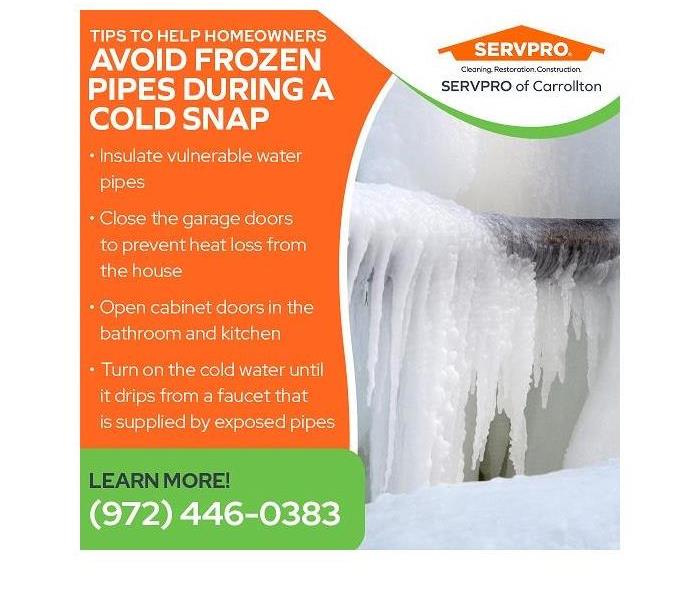Frozen pipes and winter storms: How to avoid water damage caused by pipes freezing
12/22/2022 (Permalink)
Blog Summary: SERVPRO® of Carrollton warns Carrollton, TX, homeowners that water pipes can freeze during a cold snap and urges homeowners to take measures to prevent their pipes from freezing.
The team at SERVPRO of Carrollton provides flood restoration services for homeowners and businesses that have suffered flood and water damage. In recent years, some of the worst water damage in the Dallas/Fort Worth area occurred from frozen pipes that burst and not from storm damage. To help avoid the disaster that hit North Texas in February of 2021, SERVPRO of Carrollton shares tips to prevent frozen pipes from a cold snap. The best time to take steps to prevent flood damage from frozen pipes is when the weather is mild and the threat of burst pipes is low.
Relationship between lower temperatures and higher risk of frozen pipes
The experts at Consumer Reports explain the relationship between low temperatures and the elevated risk factor, writing, “When temperatures plummet, the risk of your pipes freezing and bursting skyrockets. In fact, burst pipes are one of the most common causes of property damage during frigid weather and can cause thousands in water damage—easily $5,000 or more, according to the Insurance Institute for Business and Home Safety.”
Pipes in unheated spaces, such as the garage, attic, or basement, are most vulnerable to freezing. Fortunately, homeowners can take simple steps to prevent pipe freezing and eventual pipe failure. Below are tips to help homeowners avoid frozen pipes during a cold snap.
Tip #1. Insulate vulnerable water pipes
Pipe insulation is very affordable, costing about fifty cents per foot at the local home improvement store. Installation is simple, easy, and quick if crawling under the house is not a traumatic experience. The inconvenience of waterlogged carpet, the loss of keepsakes, and the cost of deductible far outweigh the inconvenience and expense of insulating exposed pipes or pipes running through the attic or exterior walls. Do not leave space or gaps between the segments of insulation. Although an adhesive strip is designed into most foam tube insulation, use durable, high-quality duct tape, electrical tape, or zip ties to keep the insulation in place and snugly closed around the pipes. Exposed pipes are a water damage disaster waiting to happen. The first and best step to preventing water damage from burst pipes is to make sure vulnerable pipes are properly and adequately insulated.
Bonus tip: Be aware of the “temperature alert threshold.”
The “temperature alert threshold” is the point at which a cold snap becomes a danger to exposed pipes or pipes that run through an uninsulated space such as an exterior wall or the crawl space. This threshold is 20 degrees Fahrenheit. If the forecast is for temperatures in the low twenties, it is time to prepare to prevent frozen pipes proactively. Hopefully, all necessary insulating was completed long before the threat of a deep freeze such as occurred in 2021.
If the temperature alert threshold is reached, the goal is to keep pipes warm, and the water running. This strategy seems counterintuitive to the conservation of water and energy. However, if pipes burst and a water damage disaster occurs, the time, effort, money, resources, and energy required for the cleanup and restoration project far outweigh the use of water and the extra electricity to keep pipes warm and the water running.
Tip #2. Close the garage doors to prevent heat loss from the house
Wind swirling through the garage allows heat loss. Often, the attic area above the garage is insufficiently insulated or not insulated at all. The heat transfer can put a strain on the heating system in the home. If the laundry room is in the garage, then the exposed supply lines to the washing machine are susceptible to freezing. Also, the water retained in the water pump of the washing machine can escape and ruin the unit. Keep the laundry room warm, and make sure that all exposed pipes in the garage or the attic above the garage are insulated.
Tip #3. Open cabinet doors in the bathroom and kitchen
This simple technique allows heat from the home to circulate under sinks and cabinets, keeping faucet supply lines warm and flowing.
Tip #4. Turn on the cold water until it drips from a faucet that is supplied by exposed pipes
Five drops a second, almost a trickle, will keep the water flowing. If temperatures drop far below 20 degrees Fahrenheit, it might be necessary to increase the flow. One to two gallons an hour down the drain is much more efficient than 7 gallons per minute on the floor which is what a burst supply line emits.
Tip #5. Maintain a constant temperature in the home
Keep the home warm throughout the day, evening, and morning to prevent pipes from freezing. The house will retain some heat, lessening the load on the HVAC system, the fireplace, or the wood stove.
Bonus tip: Inspect the attic, basement, and crawl space for consistency in insulation. Where needed, increase the insulation to keep in the heat and keep out the cold. The extra insulation will also help keep summer cooling bills under control.
In case flood restoration services are needed because of a burst pipe, the team at SERVPRO of Carrollton is available 24/7, 365 days a year. A team can be onsite in about an hour. The customer will receive an estimate with detailed documentation, including images and video. The staff at SERVPRO of Carrollton can handle the insurance claims process from end to end.
To learn more about flooding and water damage cleanup services for homeowners and business owners in Richardson, TX, contact SERVPRO of Carrollton by calling (972) 446-0383 or emailing office@SERVPRO10952.com.

 24/7 Emergency Service
24/7 Emergency Service
